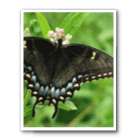|
While the fruit is edible the leaves are highly
toxic releasing hydrogen cyanide when crushed. You can find
details about the various uses for black cherry bark at
Plants for a Future.
The black cherry tree has a rapid growth rate and produces fruit
at a young age which must be fully ripe otherwise it will have a
bitter flavour. It is suitable for cooking in jams, pies, cakes
and is used to flavour drinks and ice creams. Black
cherry timber is valuable as a cabinetry timber with a fine grain
and strong red colour. It is easy to work, strong and
durable. The wood of the black cherry is used to smoke
foods giving a unique flavour to cheese and smoked meats. |
|
 |
It seems wonderfully apt that the caterpillar of the
Tiger Swallowtail, which can have similarly coloured black
wings, feeds on the black cherry, despite the poisonous cyanide. |
|
|